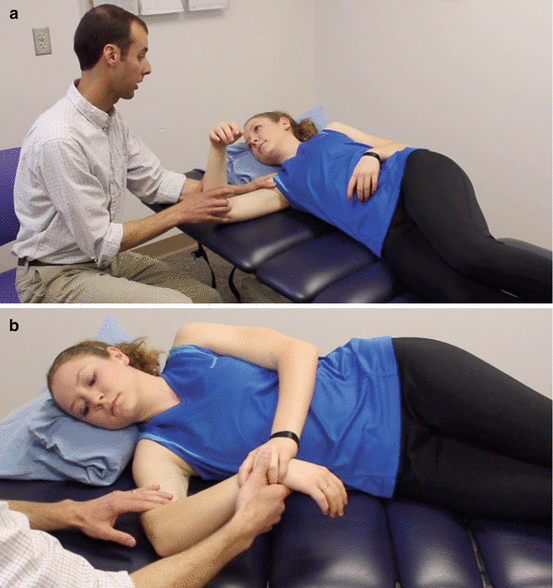Fig. 21.1
Demonstration of table slides. (a) Proper alignment and scapular stabilization are confirmed prior to stretch. (b) Therapist guides terminal stretch to avoid impingement and scapular dsykinesis
Supine cane flexion: Similar to the supine cane external rotation stretch described above, the nonoperative hand guides the operative arm into forward flexion. The goal is to increase overhead motion with slightly increased muscle activation compared to table slides.
21.6.2 Active Motion Phase
When the above goals are being met, the patient can progress to the active phase of rehabilitation. This should begin as pain levels allow and as the patient is able to control compensatory movement patterns through his/her available range of motion. This ensures that as new passive range of motion is achieved the patient utilizes this new range actively, which promotes functional carryover. Goals of the active phase are to control pain and inflammation, continue to increase passive ROM, prevent scar tissue formation, increase active ROM, and improve functional upper extremity (UE) use with activities of daily living.
Treatment during this phase should continue with early phase treatments as needed to achieve full ROM. In some cases, the surgeon may choose to modify parameters of the patient’s home stretching exercises. For example, if pain is decreasing and a firm end-feel is achieved during a stretch, the patient may be instructed to perform low-load long-duration holds at the end range. This increases the total end-range time (TERT) to achieve plastic collagen deformation, which promotes greater gains in capsular mobility [1, 3]. Additional treatments may include rhythmic stabilization drills to restore neuromuscular control and reduce compensations during active movement.
Patients will be given exercises during this phase to achieve the above goals which include, but are not limited to, the following:
Passive ROM progressions
Sleeper stretch: To promote posterior capsular mobility it is important that the patient isolate the targeted tissues. If anterior shoulder pain is present, he/she may be creating impingement and the exercise should be stopped. A modified position is often used to target a greater portion of the posterior capsule [9]. Instead of being positioned directly lateral the patient may roll the trunk partly toward a supine position to place the shoulder in the plane of the scapula (Fig. 21.2).

Fig. 21.2
Demonstration of the sleeper stretch. (a) Proper starting position is established with therapist assistance. (b) Patient utilizes unaffected arm to perform the stretch
Doorjamb series: This exercise is a progression from the supine stretch for ER. It is performed standing in an open doorway. With the feet fixed on the ground and the palm against the door frame the torso is rotated until a stretch is achieved. Further progression can be obtained by gradually increasing the angle of arm elevation in the doorway.
TV-watching stretch: This combined exercise emphasizes both ER and abduction end-range stretch simultaneously. Hands are placed on the forehead and the elbows are allowed to fall into horizontal abduction. When this becomes comfortable the patient progresses to hands behind the neck.
Cane flexion on a 45° incline: Performed the same as the supine cane flexion but the inclination increases the amount of muscle activation in a partially against-gravity position.
Standing prayer stretch with exercise ball on wall: This exercise mimics a table slide, but in the standing position. Adding the anti-gravity position promotes greater muscle activation in a more functional position.
Active ROM: This is begun in the scaption plane (full can position), as this will reduce the likelihood of impingement [16]. Again, the patient should be monitored for compensatory movement patterns or scapula dyskinesia.
Prone shoulder extension, horizontal abduction (thumb up), and forward flexion (thumb up): These exercises are done to promote active GH elevation, as well as scapula stabilization and control. Emphasis should be placed on mid/low trapezius activation, while minimizing excessive upper trap contraction in order to decrease the “shrugging” that is commonly seen in this patient population.
Side-lying ER and horizontal abduction (without resistance): The goal of this exercise is to increase rotator cuff activation. Placing a towel roll/bolster under the arm increases the subacromial space and improves supraspinatus activation [7].
21.6.3 Strengthening Phase
The third phase of postoperative rehabilitation for frozen shoulder is the strengthening phase. The patient may progress to this phase as pain levels allow, and if active ROM nearly equals passive ROM with good quality movement pattern. Goals are to continue to address passive and active mobility as mentioned above, while also improving the strength and endurance of the shoulder girdle musculature. Any or all of the above treatments should be continued as needed to achieve full shoulder mobility. Additional exercises to promote closed kinetic chain (CKC) and open kinetic chain (OKC) shoulder strength may include, but are not limited to the following:
Internal and external rotation using elastic resistance band: This is done to increase rotator cuff strength and decrease impingement with AROM.
Wall push-up: In this exercise the patient is standing and performs a standard push-up against the wall. This position allows for CKC GH stabilization and serratus anterior strengthening to promote good force coupling and minimize deviations with active movement [13].
Stay updated, free articles. Join our Telegram channel

Full access? Get Clinical Tree








